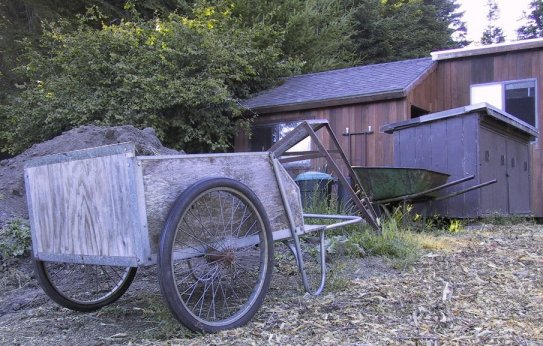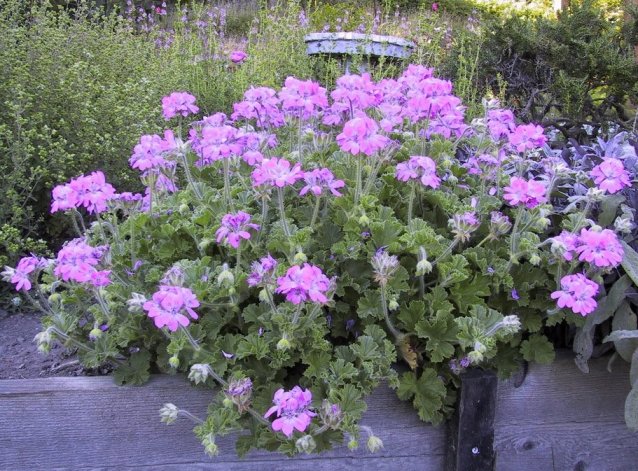

Chair Tom Warnock
called the Steering Committee meeting to order under the cherry
tree on Friday afternoon,
Tom reported that
there is no financial report this time, but that the Garden
remains in good shape. No new news on negotiations with the Baker
estate. Final plans for the June 23, 2004 Work Party were made.
(Ed.: It was a great success. The goal of spreading chips on the
main paths accomplished, and a fine picnic lunch followed. About
35 Gardeners participated.)
Discussion
continued from previous meetings on the emergency telephone
matter. Each day will have a cell phone brought by a Gardener.
Installation of a permanent cell phone will be pursued. A
Gardener has offered to set up a solar panel electricity source,
and several offers have been made to donate unused cell phones.
A sign will be made and installed giving the Sheriff’s
dispatch number to call for emergencies: 707-565-2121.
The Posh Squash
Cookbook project is rolling on, led by Colette and Norm Coad,
Ralph and Dianne Rasmussen and a crew of enthusiasts.
Congratulations to the Cookbook crew!
Ken brought the
Committee up to date on the Planting Schedule. The perennial
matter of effective watering was discussed… again. There
are about 100 surplus tomato plants, which the Committee decided
to make available to Gardeners, and to donate the rest to the
Redwood Coast Humane Society to sell at its big event. (All the
donated plants were sold, the Humane Society gratefully
reported.)
While recognizing
the great value to the
Upon Ben’s
recommendation, the Committee voted to approve the expenditure of
$150 to $180 to construct and install tip-up lids for the compost
bins. With that, the meeting adjourned.
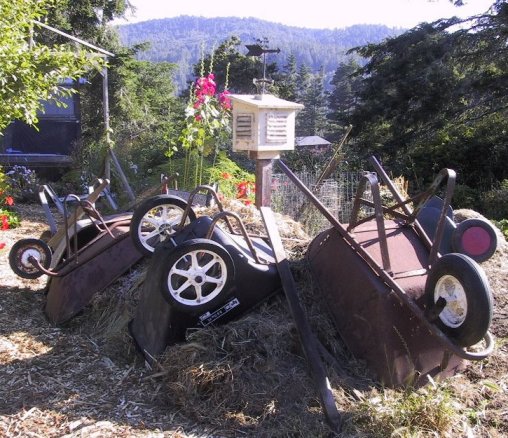
Meeting on
The Garden
presents to the eye a delightful prospect of maturing plants.
The Committee, seated at the tables under the cherry tree, had
only to look around to see how well the Garden is doing.
Cucurbits are doing especially well this year, and the fava beans
are setting up. Garlic is drying in the shed, a good crop but not
as abundant as last year. Calendulas line the main path in a
golden show. Tomato blossoms have become tomatoes in great
profusion and need only sun, sun, sun to ripen. Everywhere,
something good!
Wink Franklin told
the Committee, “We’re in good shape financially. The current
balance is $3800.” Of this, $1800 is earmarked for Posh
Squash Cookbook publishing expenses, which will be returned, plus
profits, as revenue from sales comes in.
Again, Tom and
Ralph reported no change in the situation with the Baker Estate.
Since new Directors have been elected to the Board, the Committee
plans to renew its conversations with TSRA.
The overall
Planting Plan is fulfilling itself before our eyes. Since Ken
Holmes, Planting Coordinator and Chair of the Planting Committee,
was away, Tom gave a status report. He observed that we are now
into replanting. Six beds will have been harvested soon and will
be up for replanting. The first carrot crop is over and that bed
will be replanted to carrots. Cauliflower, cabbage, beets and
some other crops will be planted.
For all the weal
and vigor of the Garden, however, the Committee was reminded of
the necessity to continue to coach new Gardeners and to remind
old Gardeners how to correctly harvest crops, especially peas,
beans, kale and chard. To avoid damage to the fragile vines by
rough handling, a knife or scissors should be used to cut the pod
from its vine below the blossom point. Also, large peas and beans
past their prime should be cut off to encourage more blossoms.
Day Leaders will coach their crews. Sections of the Planting Book
pertaining to correct picking will be duplicated and distributed.
After working on
it off and on for a year, the Committee voted to approve
the latest written version of the Garden’s Organizational
Plan. It also approved a preamble to the Plan as well as text
prepared by Chester Case to give the rationale for a written
plan, to enumerate salient principles and practices, and to give
a brief description and history of the Garden. With a cover
letter from Chair Tom Warnock, these materials will be printed up
and published as a special issue of The Compost Heap.
There is more
construction on the horizon. Ben will be starting in on a better
storage facility for the Reemay ™. The Committee approved
the expenditure of about $320 for materials for two new raised
beds. Due to increased activity of the underground gang, wire
mesh will be laid down to frustrate the gophers, moles, and
voles.
The Posh Squash
Cookbook will probably be in the hands of the Gardeners who
signed up so readily for advance orders before this newsletter.
A display copy is in the shed to be admired by all. A fine job,
and congratulations to the hard-working, resourceful and
energetic crew led by Colette Coad.
The next meeting
of the Steering Committee will be
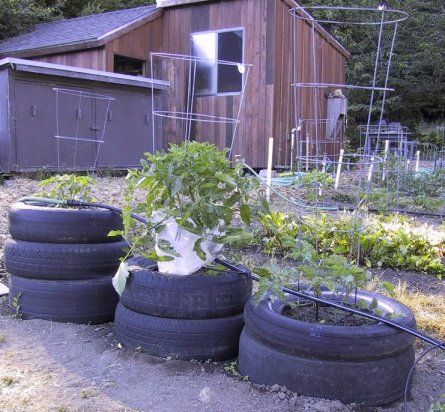
· Water
is the Life of the Garden. Even in foggy, damp weather,
watering must continue for newly-planted seeds and seedlings.
· Harvesting.
The Garden’s bounty is coming into season. Time to exert all
care and caution in correct, respectful picking of our many
crops. Pea picking can harm the plant if not done with care and
consideration for the fragile vines. Use a knife or scissors to
cut the pea or bean from its vine below where the blossom was.
Pull off over-large peas and beans to encourage further
blossoming. Same for runaway zucchinis and summer squash. Kale
should be broken off, not cut, from the stem, taking the outside
leaves. Break off dry or too-old leaves and put them in the
compost. Consult the guides to picking in
the Planting Book, or ask your Day Leader or an experienced
Gardener if you are unsure of how to proceed with correct
picking. Pay close attention to the color-coded ribbons.
· Compost:
Garden Gold. Now that we are pulling up harvested plants,
thinning, pruning, and weeding a lot, take special care in what
you put where in the Compost Works. Our diligent composters,
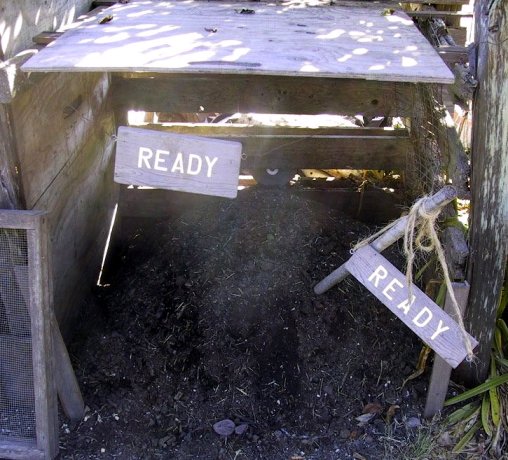
Numerous Gardeners
have taken a liking to some particular crop and adopted it for
special attention. TCH counted about a dozen fortunate such
crops. Kind of like “Plant Parenthood”? All
Gardeners garden all the Garden, of course, but here and there,
special connections have been made.
Roz Bray adopted
the bed of rhubarb. Mary Alinder tends the sorrel patch. Mary
Hunter can be seen caring for the asparagus patch. Pam Zimmerman
keeps her eye on the gourds, and Tom Warnock is particularly
concerned for the pumpkins. Shirley Case has a special interest
in the bed of bulb fennel. John Haw checks in on the
olallieberries. Erin Todhunter gives the strawberries added
attention with water, mulch, feeding and weeding. Other
Gardeners have adopted on a larger scale. Peter Farmer has led
the garlic effort for years. John Horn scrutinizes the
raspberries. MA Brauer, in addition to the Greenhouse, took
on the challenge of raising the tomatoes, experimenting with
varieties, planting, watering, mulching and heat-conserving
techniques. Brigitte Micmacker transformed the lettuce beds
with a wide variety of lettuces and greens, propagating, planting,
and making and posting informative signs on harvesting and care.
And Dianne Rasmussen, Herb and Flower Leader, has not only
increased the variety of herbs and spices, but also brought new
glories to the bloom of decorative flowers and advanced the
planting of beneficial and companion flowers.
“It is great
for plants to get extra special attention,” said Ken Holmes,
Planting Coordinator and Chair of the Planting Committee.
“Plants thrive on consistent, regular, and knowledgeable
attention in addition to the regular Garden routines.”
Anyone else feel
an attraction to some winsome plant of particular charm? Want to
complement the regular gardening routines with special care?
Plants, TCH has heard, thrive on encouraging words,
stirring the soil, a little more feeding or mulching, protection
from insects, advocacy and good PR. We welcome and encourage
Plant Parenthood, as long as it stays within the overall Planting
Plan,

The splendid Posh
Squash Cookbook is now available. If you have not seen it,
check out the display copy in the Shed. This is the second
edition of the Posh Squash Cookbook (first edition, 198l) and it
is indeed a signal achievement for all its many and various
recipes, its fidelity to Garden ingredients, its format and
flexibility. And all for the incredibly low price of $15.
If you have not
solved your Christmas shopping issues, here is a chance to do it
all in one fell swoop. Cookbooks for all, and to all a good
night!
See your Day
Leader if you have not already ordered or picked up your
cookbooks. They’re also for sale at Twofish Baking Company
on Verdant View, and in Gualala at Rumors and the Four-Eyed Frog.
Or get in touch with Colette Coad.
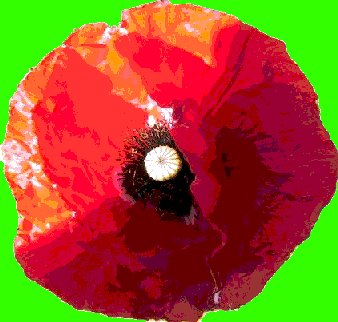
For reasons well known to all those listed
below (51 Gardeners who provided recipes) this book is gratefully
dedicated to Henry Whitesides for his gentle leadership and his
remarkable ability to convert ideas into reality. Wherever he
goes, his example will remain.
The Compost
Heap recently learned that Henry Whitesides died in his
native
Henry was one of
the Posh Squash pioneers who signed up in 1975 for “an
adventure in vegetable gardening for and by the Sea Ranch
community,” as the flyer telling about the proposed Garden
and inviting membership put it. He was one of the hardy men and
women who took on the daunting task of transforming the bare and
rocky acre. His specialty, he said, was rototilling. In a letter
to his Sea Ranch friends in 1994, he wrote, “Much of my time
in early years was spent with a small rototiller knocking these
rocks up to the surface where they could be removed by hand, one
by one… I wore out two tillers.” He did a lot more.
We digress:
editorial privilege. Sometime soon a thoughtful history will be
written to tell the remarkable story of the Garden. This
narrative will try to explain how the Garden came to be what it
is today. It is a remarkable story of a remarkable Garden with
distinctive traits that distinguish it from the common,
garden-variety community garden. It is firmly based on a vital
stakeholder ownership -- the Gardeners. A grass-roots character
combines with an effective, responsive centralization of
planning, decision- making and management. The Garden is
cooperative and communal. It relies on Gardeners’
internalization of an ethos of equability and fairness in the
distribution of the work of the Garden and in sharing its bounty.
Add to the ethos commitment to the organic approach and
dedication to sustainability and stewardship of its environment
and ecosystem. Self-governing and self-regulating, the Garden
also manages to be financially sound, prudent and resourceful in
its operations, thanks to its Steering Committee and a dozen or
more Gardeners who have individually taken on special,
above-and-beyond responsibilities. The Gardeners like the Garden.
They like to garden. They garden in a dispensation of
sociability, civility, mutual respect and consideration,
responsibility; there is a pervasive ambiance of enjoyment;
meditative, rhythmic work; and the reward of connecting
with the soil and growing things.
Back to Henry
Whitesides. He was a Gardener for a relatively short time,
1976-1981. It was a time of foundation and then transition.
Henry, leader among a group of dedicated Gardeners, swung the
Garden in the direction of its survival.
At its beginning,
the Garden was organized very differently than today. That
same flyer asks and answers its own questions:
A professional manager operates the garden
under the direction of a steering committee of members.
You send in the enclosed membership blank
along with a check for $90 ($20 is your one-time membership fee
and the $70 is for the vegetables you use). This comes to about
$5.53 per month for vegetables! For anyone living more than 5
hours driving time (or approximately 300 miles) away from The Sea
Ranch, this membership is good for two years.
Then you may help work in the garden if
you wish (but it not a required subject), you must come to the
garden to pick your own vegetables, and you will enjoy the
delicious taste of fresh vegetables, the beauty of the garden,
and the good feeling of adding to the earth’s resources
while you consume.
Editor’s note: After you picked your
vegetables (work or not!), you weighed them, referred to a price
list, calculated the costs, and had your “bill”
deducted from your $70. And you did notice that you need not work
to pick! How different is that?
The professional
manager, Judy Piner, hard-working and well-liked, nevertheless
went on to other things after several years. The Garden had
problems, like getting the watering and other work done
skillfully and in a timely way. It must have been discouraging.
Henry wrote “…(I) saw no reason to abandon the
Garden… I worked there almost every day and when a member
arrived and asked what they could do I always was able to put
them to work.”
He was downplaying
his role. Another pioneer Gardener, Phyllis McCreery, wrote of
that time, “Henry began to push the idea that the Posh
Squash could do it all, plan, plant, labor and water, without a
paid helper. And in 1980 the new garden evolved.” (Phyllis
McCreery, “Posh Squash Observations, 1977-1985”).
After the manager left and new ways of doing things set in, there
was a shakeout in membership. Phyllis recalled, “Some
members had always enjoyed working, but now there would be no
regular employee to fall back upon. Some were garden dilettantes
who shuddered at the thought of having to be responsible,
and they dropped out, encouraged by Henry who had little
tolerance for slackers. So a small dedicated band started the new
garden.”
Henry and Emma
returned to
“…(H)is
example will remain.” Henry was one of many women and men
who planted more than seeds at the Garden. They planted ideas,
visions, practices and principles. Henry was there at a time of
transition, and helped, big time, in seeing the Garden through. A
garden is a resilient thing with dynamic life forces of its own,
but it needs itself to be gardened by the likes of Henry in order
to adapt and evolve in response to changing conditions and
context. The Garden has been singularly fortunate in having had a
succession of men and women, like Henry, who appear in times of
transition to keep the Garden growing.
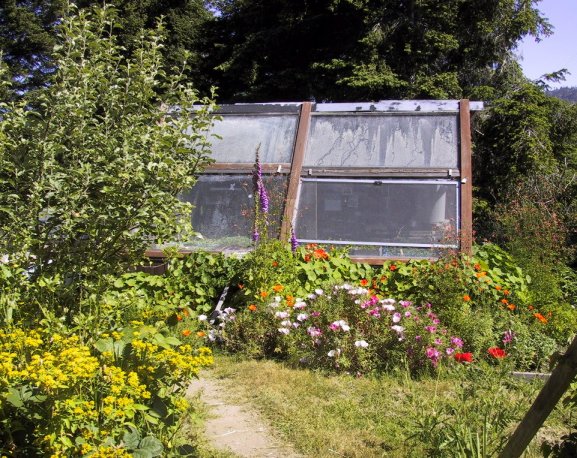
“But how does
it work?” a curious visitor to the Garden will often ask. Or
a Sea Rancher new to the Garden may wonder about the history of
the Garden, or how the crops are selected for planting. Thirty
years in the growing, the Posh Squash is a distinctive, maybe
unique, community garden. It has an interesting story worth
telling to interested people. But how?
Assistance is on
the way in the form of a booklet on the Garden. It will appear as
a special issue of TCH in the weeks to come. It will be a
handy reference for Gardeners and informative for others. In it
will be some description, history, enumeration and explanation of
Garden principles and practices, and the organizational plan of
the Garden.
